Realistic IT company strategies in crisis

Sergey Ryzhikov (1C-Bitrix)
Hello! The report is called this way - " Realistic strategies of an IT company in a crisis ."
The word "in crisis" was not there. Bunin looked and said, listen, come on, add the word “in crisis”, but somehow it is not clear. Everywhere there is a crisis, and you talk about some strategies. We need something more specific, useful to people.
')
Such a peculiar report came out, but let's see, it is curious even how it will be heard.

First, before this report you need to learn and choose such a point-position, a point of observation for yourself, as if we were not talking to ourselves. In fact, doctors even have standard practice. And parents should always know that their children are the most wonderful, they sing the best, they all get the best, a completely cloudless future, but the other children are, well, normal. Therefore, as soon as we begin to talk about our company, we become, to put it mildly, biased, and we must learn to look and discuss ourselves, sometimes even giving ourselves certain symbolic names, as if we are talking about others.
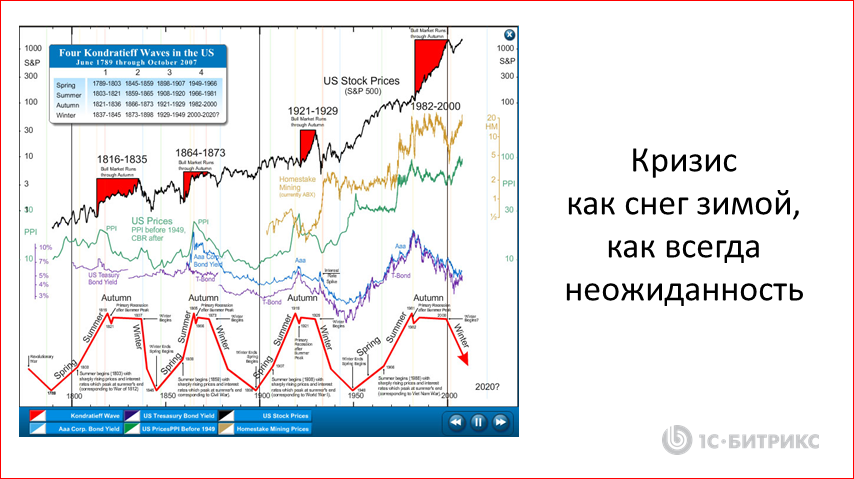
So, the crisis. Many people have already received the Nobel Prizes, defended dissertations, proved cyclical, said that this is constantly happening - there is winter, spring, autumn, everything is already on the charts, everything is known. Still, the crisis every time is as unexpected as snow in winter. Here he came the crisis. What are we going to do now? Well, great, we don’t panic in the winter, we just need to learn to live and work in such conditions. But in fact, you need to initially take it for granted, this is how the world works. Beginning in 1800, when this capitalist system appeared, the cyclical nature became very clearly understood, very clearly known. For reference, for example, in the entire history of the United States there has never been an interval of more than 9 years when a recession would not have happened. Last crisis, when, remember, was? In 2008. Let's count a little bit, and it will turn out, well, the 17th, i.e. 8-9 years, no longer work. Do not reach out.

Crises are different. It is also important to look a bit. The crisis of overproduction (well, they have produced too much), a crisis of efficiency, political, military, structural. It happens that in one industry a crisis, well, for example, this industry has become sharply restructured. There are regional crises. What is happening here, in general, is not even a crisis. This is so - we slightly woke up, and it is not even necessary to call it problems. Here, if problems begin on a global scale, and they are likely to begin, because Someone will surely defend the Nobel Prize in 5-10 years, why the crisis happened in the 17th year, why it was so deep or something else. But, we must look at it, once again, calmly. This does not concern us. Remember our point of observation? We got out and look at what is happening. Well, yes, it will.
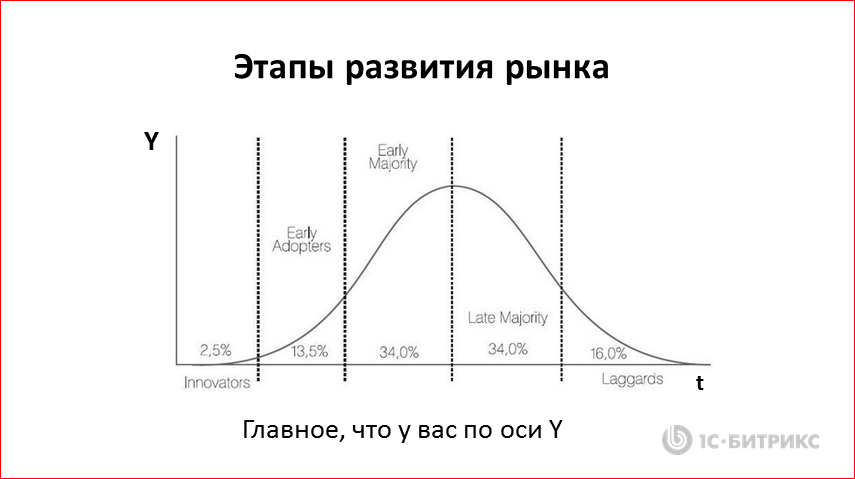
Many people know, remember this schedule. But, in general, it is some kind of strange. These are the stages of market development. What is the Y axis? If the number started to use any product, then the schedule should be up, and then - a plateau. What is there? Why do they say “at first they started using the product 2.5%, then 13.5% the group came to the following fans”? In fact, here they show how they are involved, i.e. potentially, in essence, free people, ready, receptive and calm.
If you look at the market development chart, it looks like this:

Those. there is a splash, and then it goes to a plateau. May decline slightly and goes to the plateau. But let's talk a little bit. It is very important. I will have in front of strategies a few general considerations that will help us then develop these strategies.
Well, for example, the market of washing machines. At first, no one has them. Then everyone started to buy them, they become cheaper and there is a period when everyone buys them, they are straightforward and fashion. And then some kind of flat plateau. Saturation. But he did not fall, he did not disappear, we buy these washing machines, everything is fine with them, there is a replacement, there is some cyclicality and some other characteristics.
If we look at the mobile market. Let's imagine that these two charts, the first - the 98th year, and the other - 2016. In the 98th year, mobile communications were just beginning, and there was a crisis here. From the point of view of the mobile operator, very little has changed. You grew by 500%, you will grow by 250%, you will still grow. Yes, what happens to the users? They are trying to spend less. Many succeed, but all the time there is an influx of new customers that increase your base. In fact, in a crisis in a growing market, we can generally slow down, but most likely we will not fall. And we will feel differently.
And, again, it is very important that the Y axis. What does the mobile operator have on the Y axis? The number of paying subscribers, users, potentially. And it turns out that in the 98th year the number of paying subscribers is very small. And this number goes, and today we are 150% SIM'ok. By the way, they used to say, they spoke at conferences when the mobile communication was just beginning: "We believe that everyone will have a mobile phone." Everyone says: “Yes, this is nonsense, did you see your tariffs at all? This is impossible - and the phone is for $ 2000, and your connection is gold, etc. " Now we are on a flat plateau, the number of subscribers, in fact, corresponds to the population, some ± fluctuations.
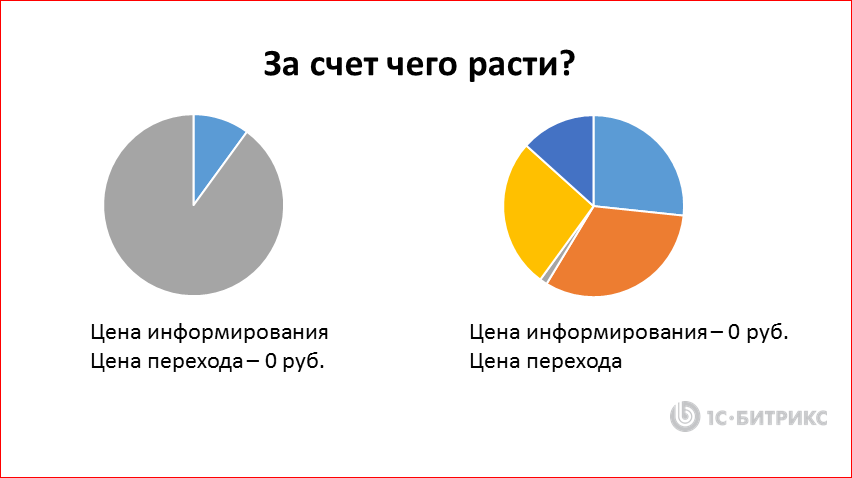
The next important point. Again, 1998 and 2016. If the market is growing and only 10% is occupied, then everyone else is free. No need to look at competitors at all. There is no competitor for you. Pay only the price of attraction, the price of informing. Those. you need to say: "There is a mobile connection" or "We have excellent washing machines."
Transition price. A very important criterion, it is very important from the point of view of building a strategy. What is the price of the transition? If I already have a SIM card, then for me a completely non-zero transfer price is to leave one and take another SIM, I have already scattered a number somewhere, etc. etc. So it turns out (this is, by the way, very much in many areas) the transition cost is substantial.
Now we look at the 2016th year - the market is divided. All competitors, there are no free people who would not know what a washing machine is, or who would not know what mobile communication is. Those. already all informed. We assume that the price of informing = 0. Although this is not entirely true, but in principle. But this nasty price of transition remains. If we assume that it is = 0, well, then it's easy, I sent SMS, I changed the mobile operator. But this does not work. Anyway, even today with MNP, the price of the transition is completely non-zero - a few days without communication, a statement, trouble, even getting up is already a hassle. Those. price barrier floats, and a lot depends on it. This price of care as well. So, in one case, in a growing segment, we have a free market; in a populated market, it is already full.

In fact, the main question in choosing a strategy is the stage of development of the market in which you are located. And the price for the transition - what is it? If the price is huge, well, are you ready to pay such a price? She can kill all the profits from how you get a person or a client. From this depends on the choice of strategy and the choice of the company.
By the way, we posted publicly available videos from the WhaleRider 2015 and 2016 conferences. Here are the relevant sheets in our account - 2015 and 2016 in our YouTube account .
Boris Nuraliev once joked well, maybe not his joke, but I heard from him: “Generally, - he says, - all companies can be divided into two types: meat and dairy production”. We are urbanized people, we don’t really remember the difference.

Meat production is a year and earned, and dairy production gives milk for a long time. Those. a cow for many years. Very simple principle. I consider him an important management principle, but in general he defines a lot.
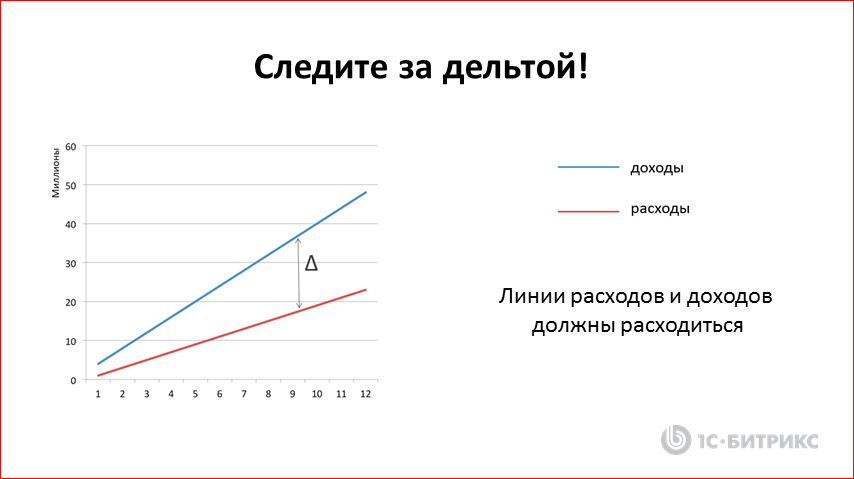
I always draw two lines - income and expenses. The whole point of the business is to increase this delta. Those. last year you made 20 million turnover, but your expenses, for example, 10 million. In fact, your income is 10 million. So everything looks simple, but how can we save it? And it’s still very simple - we have to grow next year. If we choose that we are growing at 100%, our expenses should not grow by more than 100%. Then we'll save the delta. I always follow two indicators, i.e. revenue growth rate and expense growth rate. We'll talk a little more about this part later. And if for many years you have been following, even by 5% increase the delta, then by some point you will go to 30-40% after the tax profit. Those. you have a good milk production. You regularly get milk.

The way it is. There is a dairy production. Sometimes they are called strategists, i.e. those who were able to build a big business on a large segment and a regular delta built a big one between revenues and between expenses, then they accumulate substantial money and begin to buy. Begin to buy everything that moves.
Now we look at meat production. Your bottom line is your revenue, and your expenses are on top. Shaded is someone needs to cover. But obviously, money does not come from anywhere. Someone - either the founders at their own expense should cover this, or investors should, or someone else, but, in general, you should come up with something to cover this difference.
Sometimes there is meat and dairy production. Then everything is great. You took some money, made this rush, covered it with either your money or some other money, and you went to the dairy production. You went to a normal delta. Everything, now you have more revenue than expenses, and you earn well. Well, it seems to me a good analogy for further discussion.
So, let's try to consider the principles of company management in a growing market:

On the left I have 3 graphics, we will refer to them all the time so that they visually stand before our eyes.
We with you do not need to fight with competitors. In general, you can not pay attention to them. There are no competitors. All potential customers are free. 10% of the market is occupied, and everything else is free. Let's not pay the price for the transition, we will only pay the price for informing, for the attraction. So, the main task is to expand on new customers, a huge piece of cake, no one bothers us. Even if they are active there lead a lifestyle and actively gaining a customer base, all is well. The task is to inform the maximum number of people. Costs mainly consist of information costs and attraction costs. And the costs in a growing market, I wrote here, should grow more slowly. In principle, in the growing segment this investment peak can be found. Those. There is a reason to attract money, get a turnover and then go into the meat and dairy industry in the future.
In general, the main mistakes in the growing market are forgiven. This is such a very favorable segment. You had a row with a client, woke up in the morning, you have a new client. No reputational risk. Well, they seem to be there, but you have new customers all the time, you have a new influx all the time. You always work with a new audience. The growing market forgives many mistakes.
Principles of company management in a mature market:
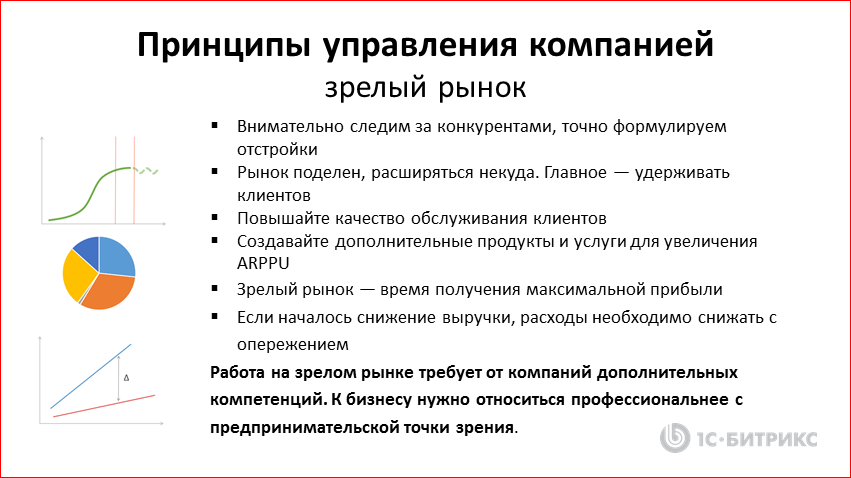
Now there is no such growth potential at the expense of free customers. The market is divided, it means that we are pushing with someone. The ideal situation is when the price for the transition is very high. As the business trainer Saminsky told us at an affiliate conference, he said that it was necessary to create conditions for the transition price to be maximum, then divide the cake, i.e. You have already reached this period and can be divided. We closely watch the competitors, we precisely formulate the tune-ups. Those. you must understand the competitors, you must know, understand their strengths, understand what they take, how they are sold, etc.
Once again: the market is divided, there is no place to expand, the main thing is to retain customers. How can I keep a client? It can be maintained by raising the quality of the product, by increasing the quality of communications, by giving additional bonuses, gifts, incentives. In principle, you can grow for the money. But at the same time, it is necessary to grow at the expense of something. Many argue that you can increase. There are there such abusive words - ARPU, ARPPU ... You can increase the average bill on clients. How can it be increased? Mobile operators, by the way, are fantastic entertainers in this matter. The base is divided, everything, there are no more clients, the population does not appear at such a speed. They introduce some new tariff plan, in which everything seems to be so cheap, but in the end you start paying more. Or is it all their stories with these SMS, subscriptions, or even some kind of horror. In principle, I am very lacking, I constantly unsubscribe my daughter on MegaFon from these endless subscriptions. How she manages to get them is not clear, but I understand that they increase their check there in this way. In general, be creative in order to increase this average check.
It may seem to many that a mature market is bad. In fact, mature is where we all wanted to go; this is the fattest market. Clients are all informed, everyone knows what a service is, or what this product means, the segment is huge, and this cow provides a lot of milk. Those. In this case, if you have a dairy production in a mature market - beauty! Because you are starting to really make money at this moment. Therefore, once again I want to emphasize that a mature market is wonderful!
A very important point. Since the mature market begins to move already together, so to speak, with the movement of the stars, i.e. with the crises that we first talked about, i.e. will regularly move up and down, then you must learn to move with it. My simple principle is to monitor income, to monitor expenses. If something goes wrong, then you have big risks to turn into meat production. I would not want to. And this means that if, for example, your revenue fell by 20%, it means that you must simultaneously lower the line, directly reduce your expenses by 20%.
As we reasoned with our fin.dirom. I trained on it. I say: "It is necessary to reduce by 20%," he: "And how to reduce?". I say: "At 20%." He says: "And how to reduce something?". I say: "At 20%."

It does not matter how you reduce, but if you do not reduce by 20%, you will turn into meat production. Therefore, we are reducing people, reducing expenses, salaries, restructuring production, changing our minds, how to do it differently. You simply cannot, for a long time at least, grow for yourself, to have the intersection of these lines.
Once again: the intersection of lines, in general, is acceptable if the growing market; If the market is mature, then the intersection of the lines is a very big problem, it’s time to think about what to do with production and with the company.
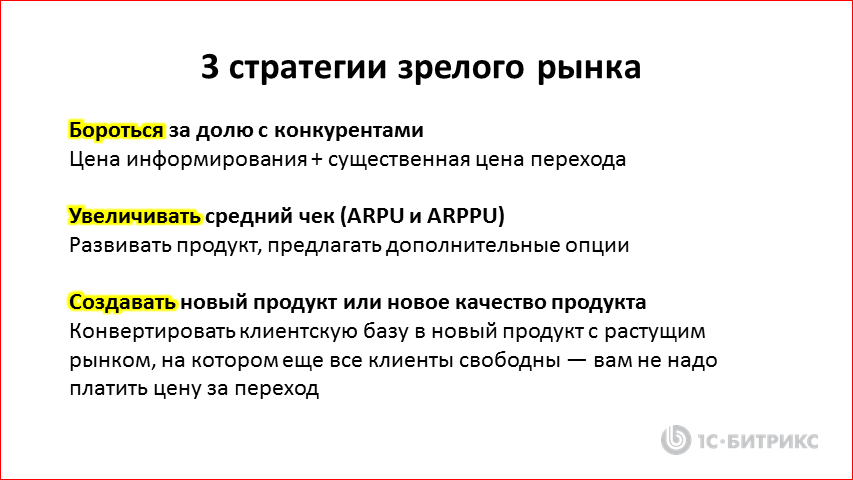
So, three strategies in a mature market.
- First, fight for share with competitors. We have an informing price and a substantial transition cost. You can fight. You remember all those stories when “hand over your washing machine, 40% discount on ours”. Remember how the replacement went to these old TVs - "bring the old TV, get some kind of discount." Those. actually reduced the price of the transition, tried to make people buy a purchase.
- I have already said that one more strategy is big, in a crisis not in a crisis - it is to increase ARPU. Those. You can increase the average bill, offering additional services, options, options, developing a product, etc., you are trying to increase the average bill.
- And the last strategy, it can be divided into two parts:
- One part is “let's change our product in such a way that the client has the feeling that this is a new product. For example, a washing machine with a dryer - let's call it something like a “washer-dryer”. And for some reason, everyone bought into this information and began to buy such a product. He became new. The mobile operator already sells not voice communication, but also sells the Internet. And remember, when the Internet mobile came, many used it for redistribution. Personally, I switched from one mobile operator to another just for the sake of mobile Internet. Then MNP was not there, I threw it out, overcame this transition price, changed SIM'ku and that's it. And he lived for a while.
- There is another technique - to invent a new product. You have come up with a new product in a growing market in which a surge is expected or you are ready to work there, and you begin to convert your accumulated client base into this new segment in order to accelerate during the growth phase. It is also quite a strategy.

Now you can try to speculate about, so to speak, realistic strategies for IT-companies. Firstly, I do not believe that IT companies are somehow different from ordinary companies. I am sure that everything is the same here. We simply treat this as our child — it seems special to us. It is very useful to go to regular conferences of offline companies, listen to how they speak, how they argue pragmatically. It is very good.

Again, not too sophisticated, I classified companies. There are software products that make software products, there are service tools that use other people's software products, and there are consulting companies that sell trust. I think that we will not talk about trust today, but first we will talk about these two types, that in general, they are in a certain sense connected.
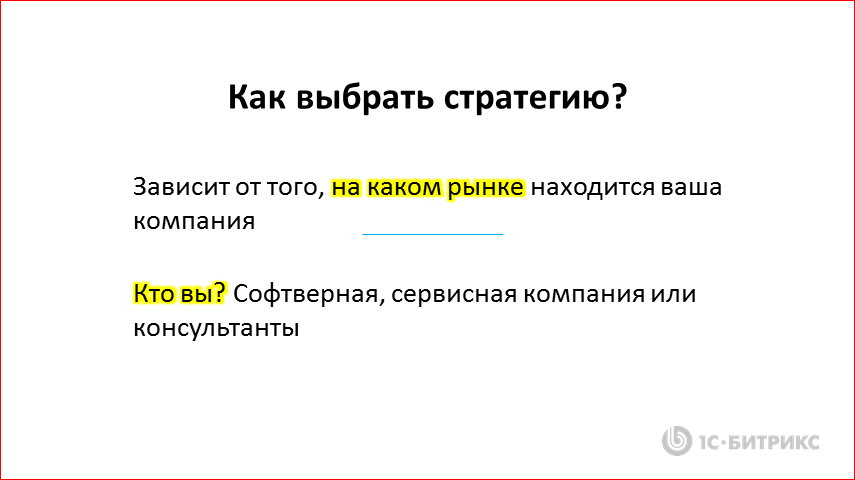
And in order to choose a strategy for your company, the most important question must be answered: in which market is your company? And a very important question: what is your y-axis? Those. can we talk about what market share is used, what do we offer, is this market a market of others? In general, you must understand whether your market is growing or not. And if this is a service company, then you need to look at the software products or markets that you use, the programs that you sell.
And again, I propose to use our three graphics:
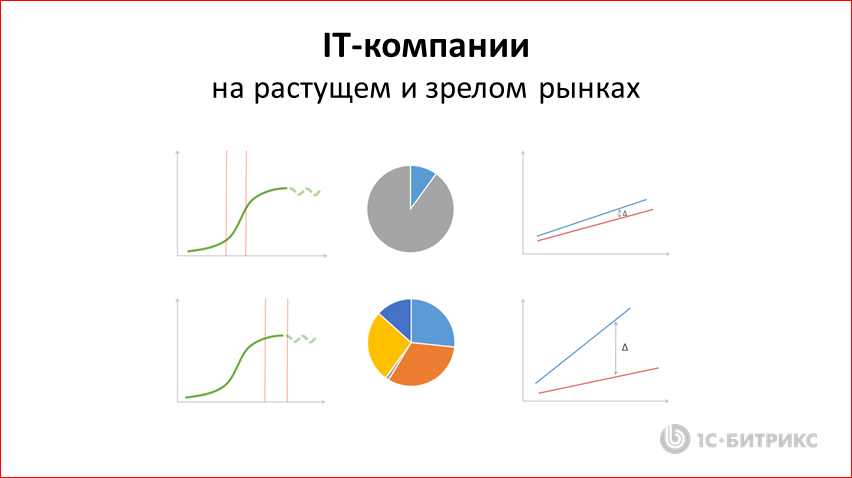
So, the stage of development of the market, the availability of free customers and the simple banal principle of the economy within your company, how it all looks and works.
Suppose we are a software company in a growing market.
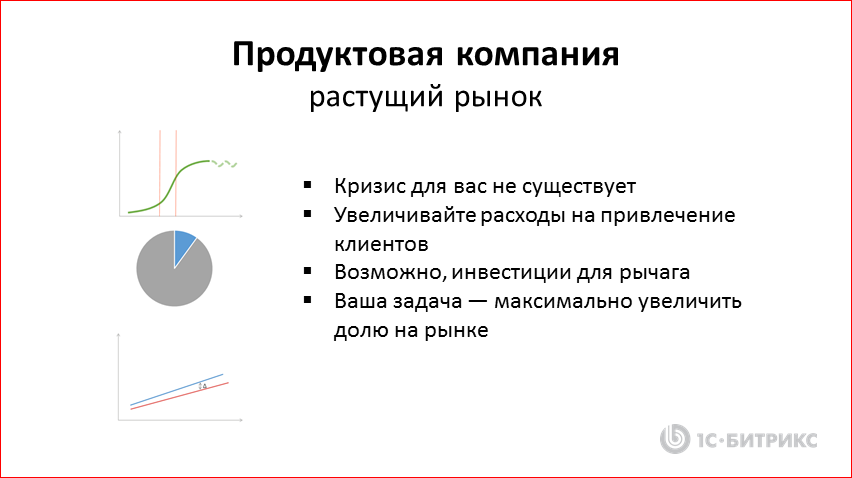
Once again: there is no crisis for us. The main task is to expand. Increase the cost of attracting customers. We, for example, very actively, repeatedly in a crisis, increased spending on the promotion of software products. Do you know, what advice is always given in a crisis? Save money. Everyone listens to these tips and starts saving. Growing, non-growing, just took everything saved. And we, on the contrary, increase expenses, because at this moment advertising prices are falling, it is much easier to reach the audience. I can give an example - now in Ukraine we are actively promoting Bitrix 24. We are promoting here too, but despite the fact that the economy is not very good and the majority is falling, the market is growing - we have more than 150% or 180% of our company. And this is super! It is in a falling market in which crisis is everywhere. Or they all say: "Yes, it is impossible to work here." It seems to me that it’s great, a wonderful moment, everyone moved away from advertising tools, and you came up. You go, bargain, negotiate, take the audience.
This is the stage when investment is possible for leverage. Yes, indeed, you show and say to an investor: “Listen, we have a growing market, we need to stake out now as much as possible. Now he is 5% busy, we want to get 20-25% from this market. ” And we need such a lever. Understandable message, it sounds good, it gives money for it, the main thing is to follow the lines. At this stage, the main task is to maximize the share. This is for a software company.
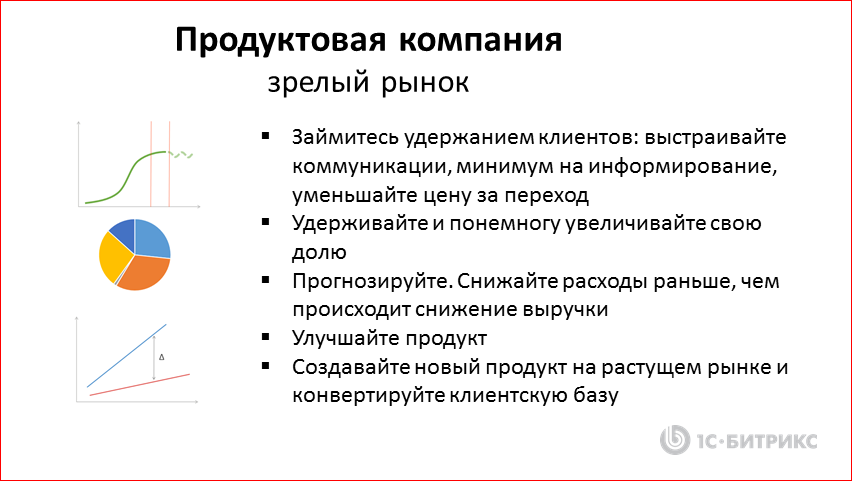
Now, if we are talking about a mature market for a software company. Once again, I emphasize that a mature market is great, even a very good one. Here you need to understand that in general there will be no longer many potential clients. As always, there is an influx, an outflow, but, in general, a certain amount. We say that we went to the plateau. It is necessary to attend to the retention of customers, because they no longer become, if we quarrel with them, it means that they leave dissatisfied.
So, build a communication with the client. Minimum to inform, because you already have a customer base, and reduce the cost of the transition. This is also a very interesting strategy - to fight for the price for the transition. Remember how Microsoft took away from Novell. They say: "Pass your OSes - get our OSes." With databases there was such a story. Those. when the market is already close to the divided, then they begin to try to lure the neighboring segments, make all sorts of converters, manipulations, etc.
In general, all this is done in order to keep and gradually increase the proportion. In general, at this stage it becomes very difficult to quickly increase the share, because competitors usually also resist, and even if you did something, then, in general, ± 5% is already a significant change in the market. By the way, in this sense it is very interesting to see how the market changes in the ERP segment. Reports are published every year, I see every year how the share of 1C increases, the share of other players decreases. This is a long strategy game, of large marathoners who have built a strategy and are increasing their segment.
It is very important to predict. Why? Because you are already big and, for example, if you have an increase in expenses by 10% more than revenue growth, this is already a decent amount of losses. Therefore, it is important to predict very accurately. And you need to reduce costs before your revenue falls. Complicated. The question is: how? So like this. Because we are as usual? They spent on advertising, and then we look after 3 months, and we still don’t believe ourselves - something isn’t growing. Then we look again, again something is not growing. Yes, let's kill the ads. And it may already be too late, it may turn out that at this moment you have already switched to meat production.
So improve the product. Yes, a very good strategy to give your product some special qualities. If you recall, this happens in ordinary markets, i.e. There may be some special watches. In principle, the segment is classic, but they become some kind of special. Washing machines and other devices or devices may appear that cause the customer to feel that this is still something new. This is a tweak that allows you to redo a bit of a segment. And again, create a new product in a growing market and convert the customer base into a new segment. It is also quite a productive strategy.
We will talk a little about the service company in the growing grocery market.
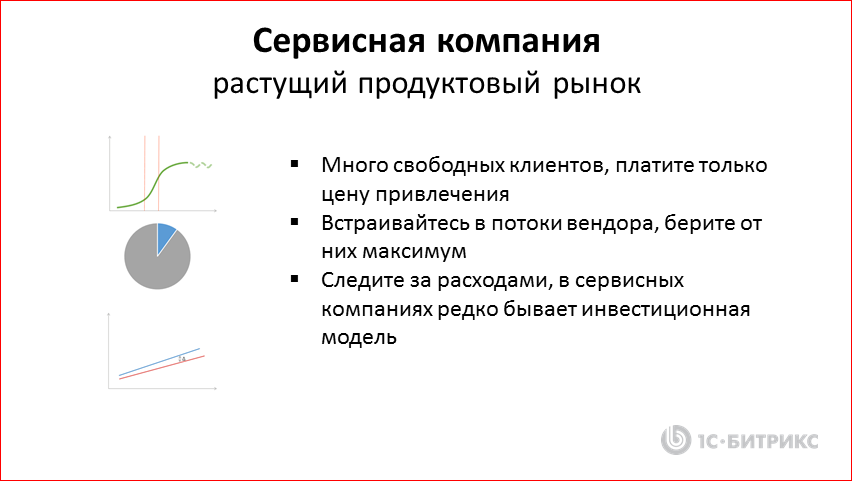
It turns out that a service company does not seem to have an independent strategy, it must rely on the vendor’s strategy. In principle, everything is very similar, a lot of free customers and you need to pay only the cost of attraction. Basically, service companies are always starting to look at competitors and fight for these customers, who, in principle, well, took and took. The market is free, there is nothing to fight for it. He will come, he will suffer, he will come, he will be ready. No, anyway, they make super offers, they start to fall in price only to get this client. This is not entirely correct. Once again: in a growing market it is better and preferable to fight for new customers.
So, we build in the vendor stream, take the maximum from it. A vendor is in any case interested in advertising and expanding its share, and it is often possible to integrate into communication flows.
And, probably, the most important thing for a growing company is to keep track of expenses. Service companies rarely have an investment model, i.e. straight rarely happens. By and large, the service company is a dairy production. And this means that, in general, expenses and incomes - there should be a delta between them and preferably a positive one. Moreover, service companies rarely buy. Grocery, even ill, so to speak, companies - meat production can turn out. And with a service company, it can stay right in the field like that, unnecessary to anyone, i.e. it may not be possible to make some kind of additional business out of it.
Service company in a mature grocery market:
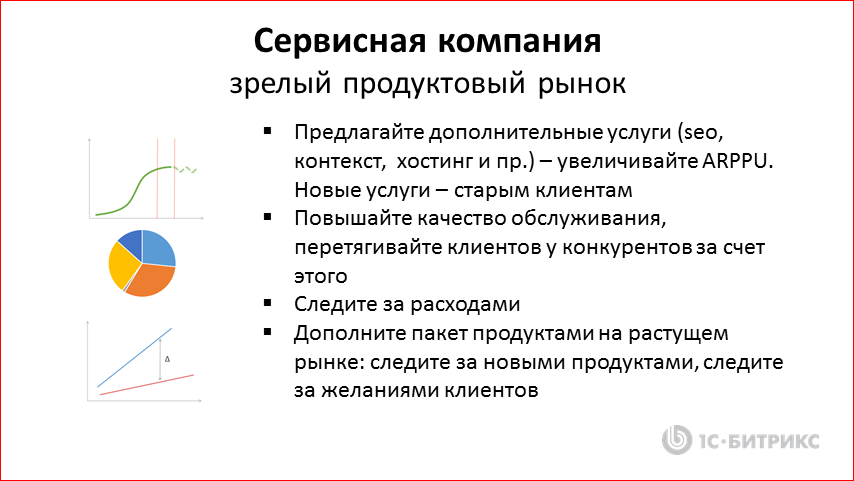
We offer additional services: service, context, hosting, analytics ... The most important thing is to differ from the rest. You need to paint yourself so much, you have to position yourself so that you look completely different. Here AGIMA is a great example of how to position yourself differently on the market, look confident and build production differently. In principle, the client is of little interest, or rather, he is not very competent, what happens behind these parts. It may be justified, it may not. You must be different.
And necessarily new services are needed. New services and old customers. All the time you need to invigorate them, all the time you need to maintain relationships and create a sense of movement with these customers.In general, the client often has the feeling that "we are not offering something new for a long time with this company." And he can try to switch. What, by the way, can be the price of the transition? If the product story is the same, the cost of the transition may not be very large. Yes, communications are changing, people are changing, and the price of transition is there. Well, you can try to increase it. You can try to create the feeling that you always have a fresh new product.
I stress once again: improving the quality of service, over-tackling customers from competitors at the expense of quality, first of all, not at the expense of price. Because you will begin to pull at the price, you will squeeze yourself with your clients, as a result you will not earn money.
It is very important to keep track of costs, we have already talked about this. And it is important, probably, to look for products that may be useful, products of growing markets, i.e. expand your portfolio with different products with different offers.
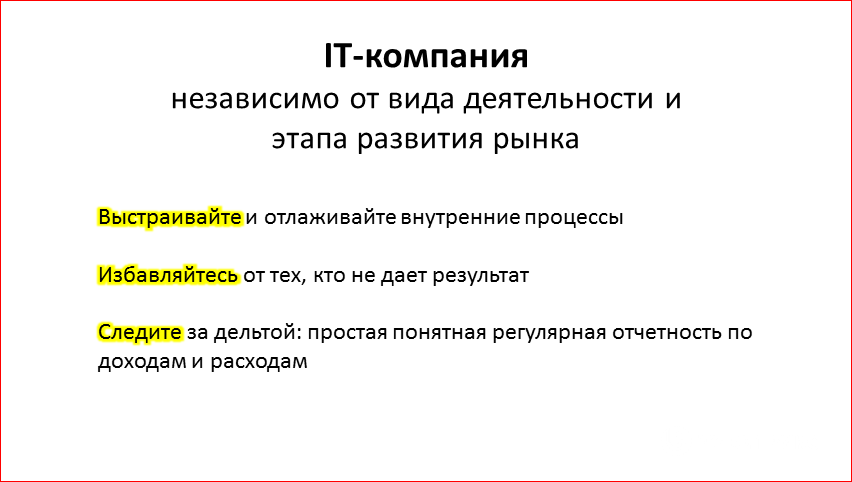
So, regardless of the type of activity, there are general principles - it is to build and debug internal processes. About this much, in general, they say. And, of course, the main goal is not to lose, but to earn, i.e. so that it all becomes profitable. Get rid of those who do not give results. We, in general, especially IT's, for some reason, are very hard to change. Maybe because of the failure of the processes we hold on to people for a very long time, and often this creates problems inside. Once again: in fact, it is very important to appreciate, and work with people, and recruit them correctly, but there is a whole story there that you can talk about. Again, watch out for the delta. I, probably, still will show a certain report.

This slide is for IT'shnikov, because not IT'shnikami it is not even needed. For some reason they created a business for this. And IT's very often create a business for beauty, for self-realization and for many other things.
Entrepreneurship is an economic activity aimed at systematically receiving profits from anything - from production, from sales, from services, etc. For profit. The restaurant stopped working - they closed, changed the style, changed, opened something else. Offline entrepreneurs look at it faster, without some feeling of regret, as if they are breaking up with something loved or with their child, they are easily rearranged. The market has changed, all this is no longer in trend - there is nothing to fight for this segment, it is necessary to replay, it is necessary to restructure.

Again, IT's advice: you will never be able to systematically develop your business, engage in neighboring markets, if you do not understand your role as an entrepreneur, i.e. What is this business for? Do not take control, which is also quite a big mistake, but not aware of your rights and goals, why you create a company or IT business.
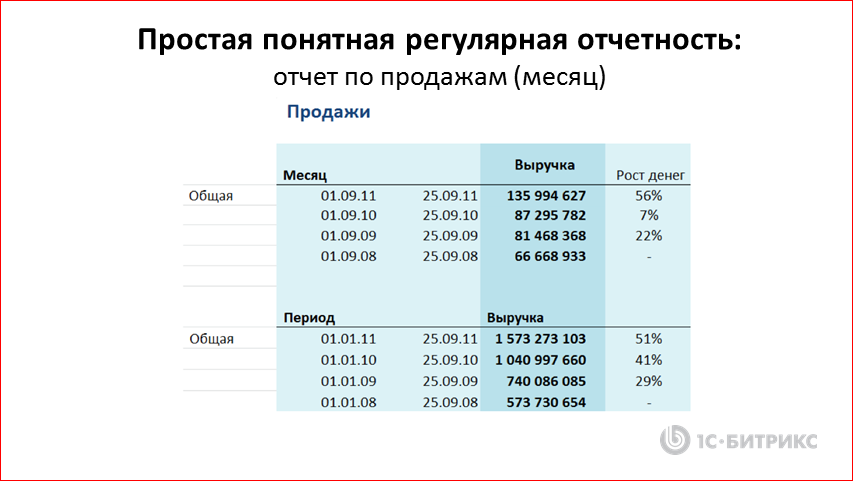
I've been trying to submit a tally. In principle, he is, but first I’ll tell you about something else.
Once there was a story. My friend from an IT company asked for advice, said: "I have to consult, something I have a cash gap." - "Well, come." He arrived and brought 100,500 reports. Right here are different - in this section, in this section. At first I tried to understand his reports, and then I said: “No, this is how we do not analyze anything, let's try differently”.
We wrote the last with him, starting in 2008, 2009, 2010 and 2011. I say: "Tell me, what was your revenue?". Conditionally 10 million in 2007, then 8 million, then 12, 15, 20. I say: “Well, let's write out how much the percentage of growth was.” 10 million - 100% growth, in 2008 - minus 20%, in 2009 it grew by 50%, here it also grew by 30% and at the end - 25%.
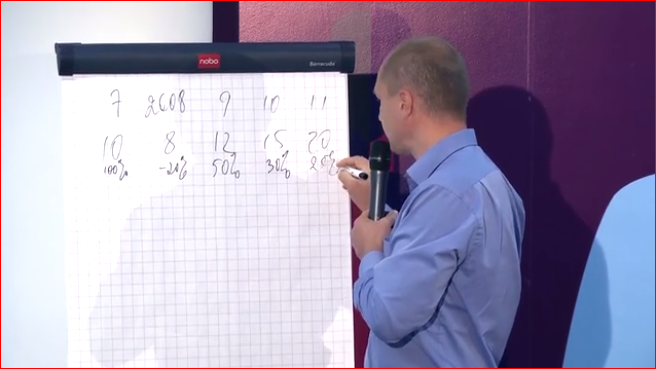
“Well,” I say, “well, about understandable. Now let's write the expenses. ” This was our income. Now costs. We started writing expenses with him. I will not think of numbers now, but it turned out the following: in 2007 expenses grew by 80%, in 2008 - by 30%, then by 60%, I felt that something was wrong, 25%, in 2011 th - 60%.

I say: “Look, in general it turns out that your lines crossed and already quite a while ago. Let's write out what your expenses were. ” Quickly looked: well, people, IT'shshnaya the company of what could consist? People. And they wrote out as a percentage how much each year his company’s number grew, in general, without delving into anything. And there was one year - in his company, I think, the number of the company increased by 600%. He had some kind of jump. Every year there are numbers, the growth rate of people was greater than the growth rate of revenue.
We quickly, literally half an hour, found a problem. It consisted in the fact that there was a conflict between the production department and those involved in implementation, and since some did not want to communicate with others, refine the product for it, in fact the implementation department hired a lot of people in order to be able to fulfill their duties.
In general, this is a very simple principle. And I highly recommend this report to you. Right on the cache - this month we received so much money at the expense of so much money, we spent so much. Next month - so much money came, so much was spent. And lump here, write the word "profit". And there either with a plus or with a minus you have written some value.
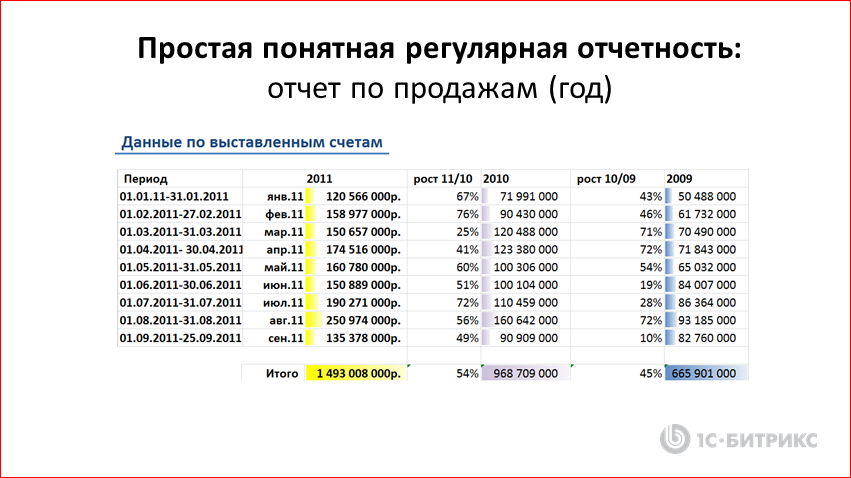
Such an accountant report you will do. We have until the 5th day of each month. The regular task of the financial director is right, and on the 5th of each month they give me a report. In fact, I get it every week, this report. But on the 5th, he is already honest, according to the results of the previous month, and it becomes clear from him.
I still love cumulative reports, i.e. I count a month, and then a year. But this is connected with what - we set ourselves the task, for example, to grow by 50%. And a very simple logic: if we want to grow by 50%, we must grow by 50% every month. So, we are looking, this month we have grown by 50% - well. Costs did not exceed the growth rate. Next month ... Ie we accumulate and so over the course of the year we look at the growth rate.
Once again, this tracking of the delta provides a very useful dialogue, for example, including with marketing or with others, when it comes to the fact that "we need to increase people." By the way, this formula is very easy to explain to managers. I draw on the blackboard and say: “You should have brought me a rise in expenses by 90% now, and our business is not growing by 90%. So you need to reduce. " And everyone is looking at this chart and saying: “Yes, really, perhaps, it is necessary to reduce, something we diverged. We need to increase efficiency, really. "

So, very often, as an objection from IT'shnyh directors, I hear the following words: “Where can I get the strength? Where to take time? Where to find resources or the opportunity to do a new product, to restructure their production, whatever it is to do? ”. I always answer: "All reserves are always inside your company." How many employees work in our company? Many people do not know. Simple accounting, there is such, 8 hours we give work. Well, somehow people come so-so some time, they leave ... And everyone is sure, the employees are sure that they are recycling, and the managers are sure that the employees are not working well.
Simple accounting of hours. How much do you yourself sit in the social. networks? Actually, today there is such a big hole in our timeline - this is soc. networks, news and anything else. Everyone is smiling: "Yes, this is very much, this is very bad." And how many employees are sitting in the social. networks? Everybody says: “Yes, there are too many.”

How do you react by entering the room where the employee sits on Facebook? What do you say to him? Nothing.Most likely, you will not tell him anything. Imagine the situation, let's talk about offline, you come to the construction site, and the worker sits and drinks beer - “What are you doing then ?! Your time is paid, let's plaster! ". And he sits drinking. And he says: “Well, listen, I have a break now, I need Facebook.” We usually react as follows: "Oh, yes, I also saw this video, cheerful." So we actually lose so many hours of our company. And do not use them to do the work.

We even have a certain documentary in the company, but, in general, we are not accepted, let's say, not work at work. At work, we work. I do not allow thoughts, passing, if a person is sitting in the wrong format, do not tell him the remark: “Listen, this should not be so.”
I even often tell the story. There is such a theory of probability of the most probable event. If you come to the bus stop and wait for the bus for 20 minutes, then according to the Poisson law, the average bus travel interval is 20 minutes - as a reminder. And I come up and tell them this story and say: “Here, look, I went in, and you are sitting on Facebook, which means that basically, you are sitting on Facebook. And now, I can calculate the probability for you if I see you a second time. ”
You ask: “How to do? What to do then? We have an order for the company, and sometimes I just ask people to write an explanatory letter. After two explanatory rarely helps. But you do not think that we are tyrants, we also sit on Facebook, but not as much as you. The working day is 8 hours. Lunch is not included in the working day. It seems to be a trivial thing, but IT companies need to be reminded. Soc.networks and sites that are not related to the task - only at lunchtime or at home.
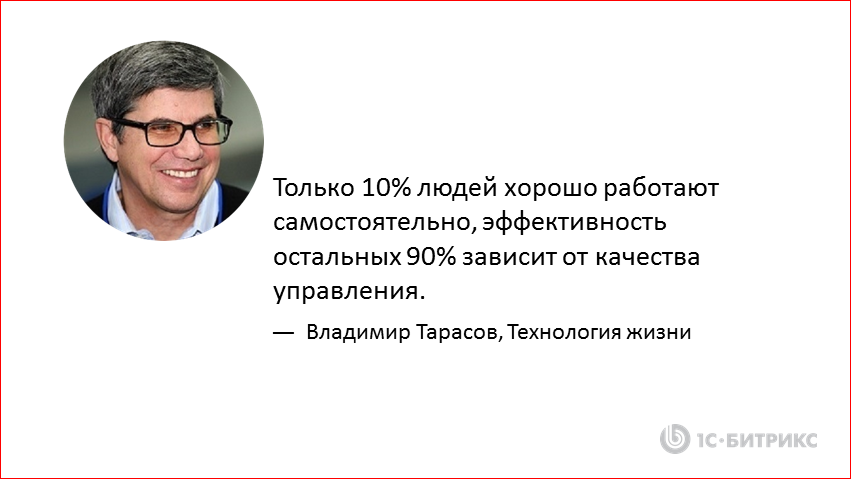
Only 10% of people work well independently, effectively, the remaining 90% need to be managed. Not in violence. We are not talking about the method of management, we are talking about the fact that the roles of the leader are becoming very significant.
In conclusion.
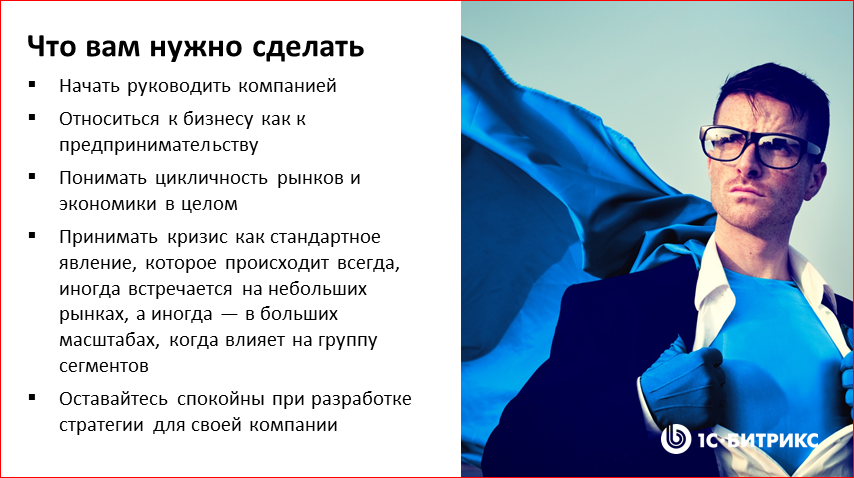
It seems to me that it is very important ... I will start from the last moment - it is very important to be calm about your company, learn to perceive. This is actually very difficult, I advise it, but I don’t always get far to look at my company not as my child. Those.somehow manage to abstract and look at it differently.
We need to start managing the company. Treat business as entrepreneurship. Understand the cyclical nature of markets and the economy as a whole. Then we begin to calmly relate to the fact that there will be a crisis, there will be no crisis, we just begin to treat this normally. And many, by the way, both expand and increase profitability and profits in a crisis, because it becomes easier to tighten the screws, it is easier to cut expenses. For example, you started to fall, you lost 20% turnover, reduce costs by 40%. Excellent - your profitability will even increase.
And it is important to accept the crisis as a standard phenomenon that always happens. Thank!
— WhaleRider .
, , — WhaleRider 2017 — 5 6 .
, " -. ".
, . Many researchers and philosophers are seriously studying how it will affect our life with you. You know, for example, that according to forecasts, by 2030 more than 40% of working people will be replaced by robots. Do you study for a driver? Very, very nothing :)
That's what we'll talk with Sergey at the conference, he practices, he sees everything as a market player. And so valuable!
You can talk with Sergei in a month at the WhaleRider conference .
Source: https://habr.com/ru/post/328340/
All Articles